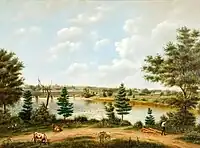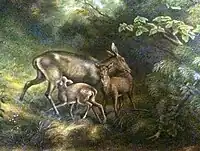Eugene Dovilliers | |
|---|---|
| Born | June 3, 1818 Paris, France |
| Died | May 20, 1887 (aged 68) |
| Occupation(s) | Artist and teacher |
| Known for |
|
| Spouse | Ellen Brenan |
Eugene Alexander Dovilliers (June 3, 1818 – May 20, 1887) was an artist in Columbia, South Carolina from the 1840s to the 1860s. He worked in oil painting and drawing. The drawings were sometimes reproduced by lithography.
Life
Eugene Dovilliers was born in Paris, France, on June 3, 1818. The original family name was De Villiers.[1] He arrived in South Carolina during the early 1840s with his father Michel and mother Zoe.[2] Dovilliers' older brother, Leopold, also immigrated to the U.S.[lower-alpha 1]
From 1847 to 1849, Dovilliers taught painting, drawing and French at Limestone Springs Female High School in Gaffney, South Carolina.[3] In the 1850 census, he gave his occupation as "Artist".[4] He taught drawing and painting at the Barhamville Institute[5] until 1853, and after that at the Columbia Female Academy in central Columbia. The founder of the Barhamville Institute, Elias Marks, wrote about Dovilliers that his "eminent skill and success ... leave nothing to wish for in this Department, whether it be in copying, or in original sketching from natural scenes."[6]
Dovilliers married Ellen Brenan, who was a skilled music teacher and performer.[lower-alpha 2] Between 1853 and 1859, he built a house in Greek Revival style that still stands today in Columbia, although not in the original location. The Dovilliers-Manning-Magoffin House is listed in the National Register of Historic Places.[10] A former student boarder at the house described the house as a "... residence conveniently situated, tastefully furnished and elegantly adorned. Monsieur is a painter of rare talents, as the walls of his rooms and chambers, richly hung with specimens amply testify ..."[11]
Dovilliers was living in Columbia when the Union army occupied it for four difficult days in 1865.[12] At one point, the house was threatened by the fires that destroyed much of Columbia. Another resident reports that he "went to Mr. Dovilliers' and helped his wife put two or three big pictures in frames on her head, which she carried over to my house, and thence beyond the Female College ..."[13]
In 1866, Dovilliers was appointed assistant professor of French language at the U.S. Naval Academy in Annapolis.[14] French was the language of diplomacy and international relations at that time and thus important to naval officers who visited foreign ports.
Dovilliers died on May 20, 1887, while still serving at the Naval Academy.[15] He was buried in the United States Naval Academy Cemetery.
Art
Dovilliers' work displays a variety of styles and media.
- Front perspectives of leading Columbia institutions – Dovilliers' lithograph of the South Carolina College's historic U-shaped campus, "The Horseshoe", is widely reproduced. (South Carolina College is now the University of South Carolina.)[16][17] A matching lithograph shows the leading college-level school for women in Columbia at that time, the Barhamville Institute.[18][19] A lithograph shows the exterior of the South Carolina Lunatic Asylum surrounded by a 12-foot wall.[20]
- Large Landscape Paintings – Dovilliers' View of Columbia[21] is a topographical landscape, showing particular buildings like the Asylum, State House and Trinity Church along the horizon.[lower-alpha 3] Duck Hunting Next to a Grist Mill features a mill that may have been located on the west bank of the Congaree River near Columbia.[lower-alpha 4] Both of these paintings are about 84 × 105 cm.
- Smaller Landscapes – Dovilliers' Locks on the Broad River is a 20.3 × 25.4 cm charcoal drawing on paper of a riparian landscape.
- Figures – An untitled charcoal drawing portrays a woman walking across stepping stones. Another untitled charcoal work shows a Native American and a woman double riding on a horse.[lower-alpha 5]
- Nature – There is an untitled oil painting on canvas by Dovilliers that shows deer in the woods. A Dovilliers still life of a pear from the Pomaria Plantation is an oil painting on canvas.[22]
Gallery
 Eugene Dovilliers, South Carolina College, c. 1850, lithograph, South Caroliniana Library
Eugene Dovilliers, South Carolina College, c. 1850, lithograph, South Caroliniana Library Eugene Dovilliers, South Carolina Female Collegiate Institute, Barhamville S.C., lithograph, Historic Columbia Collection
Eugene Dovilliers, South Carolina Female Collegiate Institute, Barhamville S.C., lithograph, Historic Columbia Collection Eugene Dovilliers, South Carolina Lunatic Asylum, lithograph, South Carolina State Museum
Eugene Dovilliers, South Carolina Lunatic Asylum, lithograph, South Carolina State Museum Eugene Dovilliers, View of Columbia, c. 1855, oil on canvas, South Carolina State Museum
Eugene Dovilliers, View of Columbia, c. 1855, oil on canvas, South Carolina State Museum Eugene Dovilliers, Duck Hunting Next to a Grist Mill, c. 1855, oil on canvas, South Carolina State Museum)
Eugene Dovilliers, Duck Hunting Next to a Grist Mill, c. 1855, oil on canvas, South Carolina State Museum) Eugene Dovilliers, Locks on the Broad River, charcoal on paper, Columbia Museum of Art
Eugene Dovilliers, Locks on the Broad River, charcoal on paper, Columbia Museum of Art Eugene Dovilliers, untitled (Woman on Stepping Stones), charcoal on paper, South Carolina State Museum
Eugene Dovilliers, untitled (Woman on Stepping Stones), charcoal on paper, South Carolina State Museum Eugene Dovilliers, untitled (Horse with Riders), charcoal on paper, South Carolina State Museum
Eugene Dovilliers, untitled (Horse with Riders), charcoal on paper, South Carolina State Museum Eugene Dovilliers, untitled (Deer), 1869, oil on canvas, South Carolina State Museum
Eugene Dovilliers, untitled (Deer), 1869, oil on canvas, South Carolina State Museum Eugene Dovilliers, untitled (Pears), oil on canvas, private collection
Eugene Dovilliers, untitled (Pears), oil on canvas, private collection
Notes
- ↑ Dovilliers' brother Leopold Dovillier (1812-1892) was a physician who bravely tended the Union wounded at Bull Run. Leopold was a long-time language professor at the Naval Academy.[1]
- ↑ Dovilliers wife, Ellen Brenan, performed as a vocalist in New York and was the daughter of a wealthy Columbia merchant.[7][8] At 18 years old, she owned three slaves.[9]
- ↑ Topographical landscapes are often associated with the 17th century Dutch and Flemish landscapes, such as View of Haarlem with Bleaching Fields.
- ↑ Duck Hunting Next to a Grist Mill is a picturesque landscape, in the style of the 16th century French painter Claude Lorrain.
- ↑ These figure drawings may show the influence of the Swiss-French artist Karl Bodmer, who visited America in the 1830s.
Citations
- 1 2 Leopold 1892, p. 7.
- ↑ Motes 2005, p. 148.
- ↑ Taylor 1933, p. 19,26.
- ↑ Artist 1850.
- ↑ Rembert 1970, p. 46.
- ↑ Cohen 1959, p. 51.
- ↑ Musical 1855, p. 38.
- ↑ Singing 1853.
- ↑ EllenBrenanSchedule2 1850.
- ↑ Register 2023.
- ↑ Boarder 1866, p. 2.
- ↑ Lucas 2000.
- ↑ Scott 1884, p. 180.
- ↑ Appointed 1866, p. 111.
- ↑ Death 1887, p. 4.
- ↑ Horseshoe 2023.
- ↑ HorseshoeCitation 1850.
- ↑ 2600 Barhamville Road 2022.
- ↑ KnowItAll 2023.
- ↑ Allen 2023, p. 4-5.
- ↑ View 2022.
- ↑ Pear 2022.
References
- Allen, Katharine (Winter 2023). "People Lived Here". Historically Speaking. Columbia, S.C.: Historic Columbia. Retrieved 11 September 2023.
- Carlisle, Catherine Aiken (May 2014). Translating the Landscape: Eugene Dovilliers (MA thesis). Univ. of North Carolina. Retrieved 4 July 2023.
- Cohen, Hennig (1959). A Barhamville Miscellany. Columbia, S.C.: The R.L. Bryan Co.
- Kibler, James Everett Jr. (May 2022). "Portrait of a Pear". Columbia Metropolitan. Columbia. Retrieved 6 July 2023.
- Lucas, Marion Brunson (2000) [1976]. Sherman and the burning of Columbia. College Station: Texas A&M Univ. Press. pp. 113–114. ISBN 1643362453.
- McMillan, Montague (1 January 1970). Limestone College : A History 1845-1970. Columbia, S.C.: R. L. Bryan Company. pp. 42–49. ASIN B000K3N2ZM.
- Motes, Margaret Peckham (2005). Migration to South Carolina, 1850 Census. Baltimore: Clearfield Co. p. 148. ISBN 978-0806352770.
- Rembert, Sarah H. (February 1970). Wilkins, Robert Pearce (ed.). "Barhamville, A Columbia Antebellum Girls' School". S.C. History Illustrated, Vol. 1 No. 1. Columbia S.C.: Sandlapper Press. ISSN 0038-3090.
- Scott, Edwin J. (1884). Random recollections of a long life, 1806 to 1876. Columbia, S.C.: C. A. Calvo, Jr. p. 180.
- Taylor, Walter Carroll (1933). History of Limestone College. Gaffney, S.C.: Limestone College. p. 19,26.
- "A New Singing Bird and Her Name". The Musical World and Times. New York. 29 October 1853. Retrieved 6 July 2023.
- "Current Events". Brooklyn, N.Y. 21 May 1887. Retrieved 5 July 2023.
- "Death of Dr. [Leopold] Dovilliers". The National Tribune. Washington, D.C. 25 August 1892. Retrieved 4 July 2023.
- "Dovilliers-Manning-Magoffin House, Richland County". South Carolina Department of Archives and History. State Historic Preservation Office. 2023. Retrieved 5 July 2023.
- "Ellen Brenan Schedule 2", United States census, 1850; Columbia, Richland County, S.C.; roll M432 Record Group Number:29, line 18-20. Retrieved on 11 July 2023.
- "Eugene Dovilliers Artist", United States census, 1850; Columbia, Richland County, S.C.; roll M432 858, line 42. Retrieved on 11 July 2023.
- "French, Painting, Music, Italian, and Drawing". Abbeville Press. Abbeville, S.C. 16 February 1866. Retrieved 5 July 2023.
- "Historic Horseshoe". University History. University of South Carolina. Retrieved 6 July 2023.
- "Music of the Week". Musical World. New York. 27 January 1855. Retrieved 6 July 2023.
- "Regular Naval Service, Appointed". Army and Navy Journal. New York. 6 October 1866. Retrieved 5 July 2023.
- "South Carolina College". Historic Columbia. Historic Columbia Foundation. 2023. Retrieved 6 July 2023.
1850 lithograph of South Carolina College by Eugene Dovilliers. Ten of the eleven original buildings depicted here remain standing.
- "South Carolina College 1850". South Caroliniana Library. University of South Carolina. 1850. Retrieved 6 July 2023.
Creator C.B. Graham (Firm) Dovilliers, Eugene, artist.
- "South Carolina Female Collegiate Institute, Barhamville". KnowItAll. South Carolina ETV Commission. 2023. Retrieved 7 July 2023.
It was sketched in about 1860 by M. Dovilliers, who taught French and drawing to the young ladies who attended.
- "View of Columbia". South Carolina Encyclopedia. University of South Carolina. 2022. Retrieved 6 July 2023.
Creator: Dovilliers, Eugene
- "2600 Barhamville Road". Historic Columbia. 2022. Retrieved 6 July 2023.